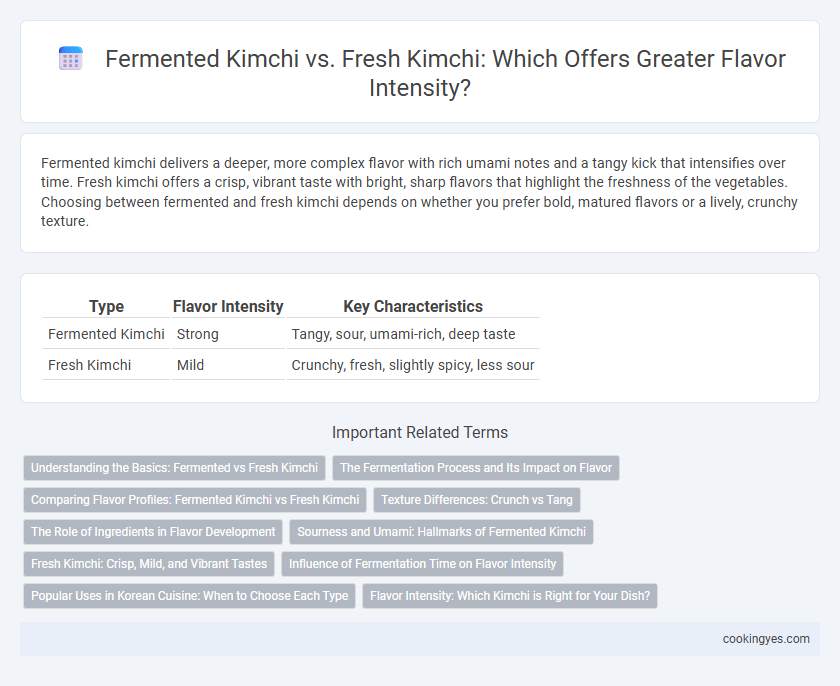Fermented kimchi delivers a deeper, more complex flavor with rich umami notes and a tangy kick that intensifies over time. Fresh kimchi offers a crisp, vibrant taste with bright, sharp flavors that highlight the freshness of the vegetables. Choosing between fermented and fresh kimchi depends on whether you prefer bold, matured flavors or a lively, crunchy texture.
Table of Comparison
| Type | Flavor Intensity | Key Characteristics |
|---|---|---|
| Fermented Kimchi | Strong | Tangy, sour, umami-rich, deep taste |
| Fresh Kimchi | Mild | Crunchy, fresh, slightly spicy, less sour |
Understanding the Basics: Fermented vs Fresh Kimchi
Fermented kimchi offers a richer, more intense flavor profile due to the development of lactic acid bacteria during the fermentation process, which enhances its tanginess and umami depth. Fresh kimchi has a crisper texture and a milder, fresher taste that highlights the raw ingredients like napa cabbage and radish. Understanding these flavor distinctions helps appreciate how fermentation transforms the kimchi's complexity and overall sensory experience.
The Fermentation Process and Its Impact on Flavor
The fermentation process in kimchi involves lactic acid bacteria converting sugars into acids, which intensifies the tangy and umami flavors, creating a more complex and robust taste profile compared to fresh kimchi. Fermented kimchi develops deeper sourness and rich savory notes as fermentation progresses, while fresh kimchi retains a crisper texture and milder, fresher flavors. Temperature and fermentation duration critically influence the balance of acidity, sweetness, and spice, directly impacting flavor intensity and depth.
Comparing Flavor Profiles: Fermented Kimchi vs Fresh Kimchi
Fermented kimchi exhibits a complex, tangy flavor profile characterized by pronounced sourness and umami depth, resulting from lactic acid bacteria activity during fermentation. Fresh kimchi offers a crisp, vibrant taste with sharper notes of raw vegetables and a mild spiciness, lacking the mellow acidity present in its fermented counterpart. The contrast in flavor intensity makes fermented kimchi ideal for recipes demanding robust, developed flavors, while fresh kimchi suits dishes requiring a bright, refreshing taste.
Texture Differences: Crunch vs Tang
Fermented kimchi develops a tangy, robust flavor profile with a softer, more tender texture due to extended fermentation breaking down vegetable fibers. Fresh kimchi offers a crisp, crunchy bite and a milder, fresher taste as the cabbage and vegetables remain relatively firm and less acidic. The contrast in texture between the crunch of fresh kimchi and the softer tang of fermented kimchi is a key factor in their distinct flavor intensities.
The Role of Ingredients in Flavor Development
Fermented kimchi exhibits a richer flavor intensity due to the breakdown of ingredients like cabbage, garlic, and chili peppers during fermentation, which produces complex organic acids and umami compounds. Fresh kimchi's flavor relies heavily on the crispness and raw sharpness of its primary ingredients, offering a more straightforward and vibrant taste profile. The fermentation process enhances flavor development by converting sugars and proteins in the ingredients into sour, tangy, and savory notes, significantly intensifying the sensory experience.
Sourness and Umami: Hallmarks of Fermented Kimchi
Fermented kimchi delivers a pronounced sourness and rich umami flavor due to the lactic acid bacteria breaking down sugars over time, enhancing depth and complexity. Fresh kimchi tends to have a milder, crisper taste with a brighter vegetable flavor, lacking the developed tang and savory notes found in aged varieties. The hallmark characteristics of fermented kimchi's sour and umami intensity result from extended fermentation, making it a preferred choice for depth in Korean cuisine.
Fresh Kimchi: Crisp, Mild, and Vibrant Tastes
Fresh kimchi offers a crisp texture combined with mild, vibrant flavors that highlight the natural freshness of its ingredients. The absence of fermentation preserves the bright, tangy notes from fresh napa cabbage, radish, and seasoning, resulting in a more delicate taste profile. Unlike fermented kimchi, fresh kimchi emphasizes a clean, refreshing bite with less pungency and a lively vegetable crunch.
Influence of Fermentation Time on Flavor Intensity
Longer fermentation time significantly enhances the flavor intensity of kimchi by increasing the concentration of organic acids, amino acids, and lactic acid bacteria, which contribute to its complex sour and umami profile. Fresh kimchi offers a milder, crunchier taste with pronounced freshness and less acidity, ideal for those preferring lighter flavors. Optimal fermentation duration varies but typically ranges from 1 to 4 weeks, with peak flavor development often occurring around 2 weeks depending on temperature and ingredients.
Popular Uses in Korean Cuisine: When to Choose Each Type
Fermented kimchi offers a deep, tangy flavor ideal for hearty stews like kimchi jjigae and robust side dishes that complement grilled meats. Fresh kimchi provides a crisp, mild taste perfect for light salads and quick accompaniments that highlight the dish's freshness. Choosing between fermented and fresh kimchi depends on the recipe's cooking time and desired intensity, with fermentation enhancing complexity and freshness preserving subtlety.
Flavor Intensity: Which Kimchi is Right for Your Dish?
Fermented kimchi offers a bolder, tangier flavor with complex umami notes developed through lactic acid fermentation, making it ideal for dishes that benefit from strong, pungent seasoning. Fresh kimchi has a crisp, milder taste with vibrant vegetable freshness, perfect for those seeking a lighter, less intense flavor profile. Choosing between fermented and fresh kimchi depends on whether your dish calls for deep, robust flavor or subtle, refreshing taste.
Fermented Kimchi vs Fresh Kimchi for flavor intensity Infographic

 cookingyes.com
cookingyes.com